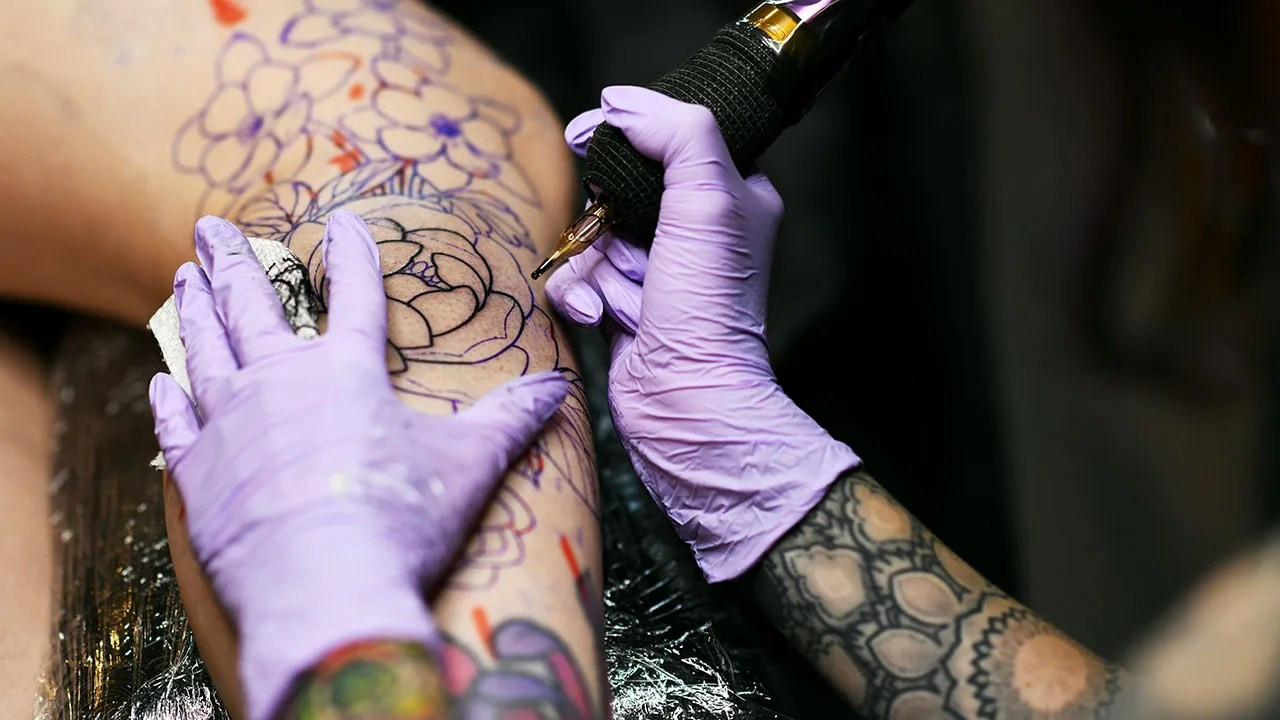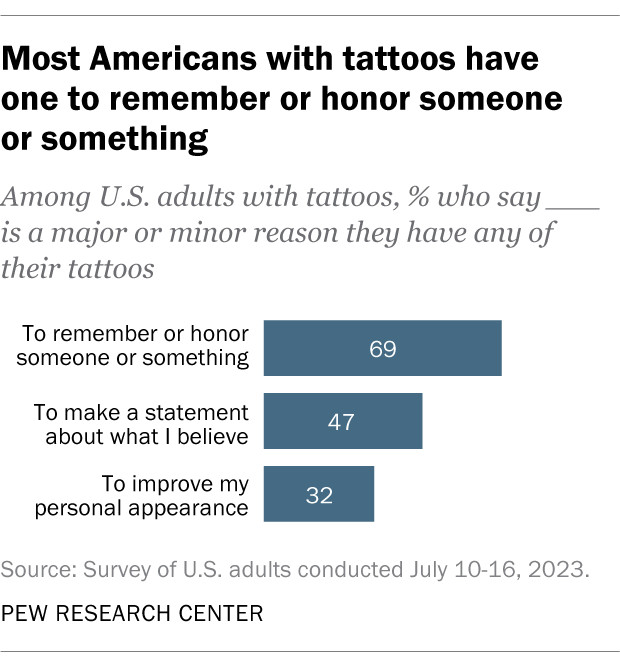Are tattoos so popular? Absolutely! Tattoo art has exploded in popularity, becoming a mainstream form of self-expression. More and more people are embracing body art, seeking unique designs and skilled tattoo artists to bring their visions to life. This trend is fueled by shifting social perceptions, the desire for individuality, and the artistry involved, all of which you can explore further on tattooat.com. Whether it’s intricate tattoo designs, finding the perfect tattoo studio, or understanding aftercare, the world of tattooing offers endless possibilities. Discover the reasons behind this phenomenon and get inspired for your own ink journey.
1. What’s Driving the Tattoo Trend?
The increasing popularity of tattoos can be attributed to a blend of social, personal, and artistic factors. More people than ever are turning to tattoos as a way to express themselves.
- Changing Social Perceptions: According to a Pew Research Center survey in July 2023, a large majority of U.S. adults feel society has become more accepting of people with tattoos in recent decades. This shift in social attitudes has reduced the stigma associated with tattoos, making them a more acceptable form of self-expression.
- Individual Expression: Tattoos offer a powerful way to showcase individuality and personal stories. People choose tattoo designs that reflect their beliefs, passions, or significant life events.
- Artistic Appreciation: Tattoos have evolved into a respected art form, with talented tattoo artists creating stunning, intricate designs. The artistry involved attracts people who appreciate body art.
- Celebrity Influence: Celebrities with prominent tattoos have played a role in popularizing the trend. Their visible ink inspires fans and helps to normalize tattoos.
- Remembering and Honoring: The Pew Research Center survey also found that 69% of tattooed adults got their tattoos to honor or remember someone or something, highlighting the emotional connection many people have with their ink.
2. Who Is Getting Tattoos?
The demographics of tattoo enthusiasts are diverse, reflecting the widespread appeal of body art across various groups.
- Gender: According to the Pew Research Center survey, 38% of women have at least one tattoo, compared to 27% of men. The survey highlights that 56% of women ages 18 to 29 and 53% of women ages 30 to 49 have tattoos.
- Race and Ethnicity: 39% of Black Americans have a tattoo, compared to 35% of Hispanic, 32% of White, and 14% of Asian Americans.
- Age: Adults under 50 are more likely to have tattoos. 41% of those under 30 and 46% of those ages 30 to 49 have at least one tattoo, compared to 25% of adults ages 50 to 64 and 13% of those 65 and older.
- Education: 37% of those with some college or less education have a tattoo, compared to 24% of those with a bachelor’s degree and 21% of those with a postgraduate degree.
- Income: 43% of lower-income adults have a tattoo, compared to 31% of those in middle-income households and 21% of those in upper-income households.
- Religion: 41% of religiously unaffiliated adults have at least one tattoo, compared to 29% of those who are affiliated with a religion.
- Sexual Orientation: Around half of lesbian, gay, or bisexual Americans (51%) have at least one tattoo. The share is particularly high among women in this group: 68% are tattooed, including 55% who have more than one tattoo, compared to 31% of straight Americans.
 A tattoo artist carefully working on a client's arm
A tattoo artist carefully working on a client's arm
3. What Motivates People to Get Inked?
Understanding the reasons behind getting a tattoo reveals the personal significance and emotional connections people have with their body art.
- Honoring and Remembering: A significant reason for getting a tattoo is to honor or remember someone or something important. According to the Pew Research Center survey, 69% of tattooed adults cite this as a major or minor reason for getting inked. This includes memorial tattoos for loved ones, symbols representing meaningful events, or designs that pay tribute to personal heroes.
- Making a Statement: Many individuals use tattoos to express their beliefs and values. About 47% of tattooed adults get tattoos to make a statement, according to the same survey. These tattoos can represent political views, social causes, or personal philosophies.
- Improving Appearance: Some people opt for tattoos to enhance their physical appearance. The Pew Research Center survey indicates that 32% of tattooed adults get tattoos to improve their personal appearance. This could include cosmetic tattoos like permanent makeup or designs that accentuate body features.
- Personal Transformation: Tattoos can symbolize personal growth, resilience, or overcoming challenges. People may get tattoos to mark significant milestones in their lives or to remind themselves of their strength and determination.
- Cultural or Spiritual Significance: For some, tattoos hold deep cultural or spiritual meaning. These tattoos can be part of traditional practices, religious beliefs, or ancestral connections.
4. Are There Any Regrets After Getting a Tattoo?
While most tattooed individuals are happy with their ink, some experience regret. Understanding the factors that contribute to tattoo regret is essential.
- Regret Statistics: According to the Pew Research Center survey, about 24% of tattooed Americans regret getting one or more of their tattoos. This indicates that while the majority are content, a significant minority experience second thoughts.
- Demographic Factors: The survey also reveals that 30% of tattooed Hispanic adults report regretting any of their tattoos, compared to 23% of White adults and 21% of Black adults. Additionally, 25% of tattooed adults with some college education or less regret their tattoos, compared to 19% of those with a bachelor’s degree or more.
- Reasons for Regret: Common reasons for tattoo regret include:
- Poor Design Choice: Choosing a design that no longer resonates with personal tastes or beliefs.
- Inadequate Artist Skill: Dissatisfaction with the quality of the tattoo due to the artist’s lack of skill or experience.
- Social or Professional Concerns: Realizing that the tattoo affects social or professional opportunities.
- Fading or Distortion: Changes in the tattoo’s appearance over time due to aging, sun exposure, or weight fluctuations.
- Tattoo Removal Options: Fortunately, various tattoo removal options are available, including laser removal, surgical excision, and dermabrasion. These methods can help reduce or eliminate unwanted tattoos, though they may be costly and require multiple sessions.
5. What’s The Future of Tattooing?
The future of tattooing looks bright, with ongoing innovations and evolving trends shaping the industry.
- Technological Advancements: Advances in tattoo technology, such as improved tattoo machines and inks, are enhancing the quality and safety of tattoos. Innovations like biodegradable inks and painless tattoo application methods are also on the horizon.
- Artistic Innovations: Tattoo artists continue to push creative boundaries, experimenting with new styles, techniques, and color palettes. Emerging trends include:
- UV Tattoos: Tattoos that glow under ultraviolet light.
- Micro Tattoos: Tiny, intricate designs that require precision and skill.
- Watercolor Tattoos: Soft, vibrant tattoos that mimic the look of watercolor paintings.
- Geometric Tattoos: Bold, symmetrical designs based on geometric shapes.
- Growing Acceptance: As tattoos become more mainstream, societal acceptance is expected to continue growing. This will likely lead to more inclusive workplace policies and greater appreciation for tattoos as a form of art and self-expression.
- Customization and Personalization: The demand for personalized tattoos that reflect individual stories and identities will likely increase. Tattoo artists will work closely with clients to create unique designs that hold deep personal meaning.
- Focus on Safety and Hygiene: With growing awareness of health and safety, tattoo studios will prioritize hygiene and sterilization practices. Clients will seek out reputable studios that adhere to strict safety standards.
6. How To Choose The Right Tattoo Artist and Design
Selecting the right tattoo artist and design is crucial for a positive and satisfying tattoo experience.
- Research and Portfolio Review: Start by researching tattoo artists in your area and reviewing their portfolios. Look for artists who specialize in the style you want and whose work resonates with you. Websites like tattooat.com can help you find talented artists and studios.
- Consultation: Schedule a consultation with potential artists to discuss your ideas and assess their expertise. Ask about their experience, techniques, and approach to designing tattoos.
- Hygiene and Safety: Ensure the tattoo studio follows strict hygiene and safety standards. Check that the artist uses sterile equipment, wears gloves, and has proper certification.
- Design Collaboration: Work closely with the artist to create a design that reflects your vision. Provide reference images, explain your preferences, and be open to their suggestions.
- Placement Considerations: Consider the placement of your tattoo and how it will look over time. Choose a location that complements the design and takes into account factors like skin elasticity and sun exposure.
7. What Are the Different Tattoo Styles?
Exploring various tattoo styles can help you find the perfect aesthetic for your ink.
- Traditional: Bold outlines, limited color palettes, and classic imagery like anchors, roses, and eagles.
- Neo-Traditional: Similar to traditional but with more detail, shading, and a wider range of colors.
- Realism: Highly detailed tattoos that aim to replicate photographs or real-life images.
- Watercolor: Soft, flowing tattoos that mimic the look of watercolor paintings.
- Geometric: Precise, symmetrical designs based on geometric shapes and patterns.
- Tribal: Bold, black designs inspired by indigenous cultures and traditional tattooing practices.
- Japanese: Intricate, large-scale tattoos featuring mythological creatures, flowers, and waves.
- Blackwork: Tattoos that use only black ink to create bold, graphic designs.
- Minimalist: Simple, understated tattoos with clean lines and minimal shading.
 A collection of diverse and vibrant tattoo styles, showcasing the artistry and creativity in body art
A collection of diverse and vibrant tattoo styles, showcasing the artistry and creativity in body art
8. How To Take Care of a New Tattoo
Proper aftercare is essential for ensuring your tattoo heals well and looks its best.
- Keep it Clean: Gently wash your tattoo with mild, fragrance-free soap and warm water 2-3 times a day.
- Moisturize: Apply a thin layer of tattoo-friendly moisturizer to keep the skin hydrated. Avoid using petroleum-based products.
- Avoid Sun Exposure: Protect your tattoo from direct sunlight by wearing loose clothing or using sunscreen.
- Don’t Pick or Scratch: Resist the urge to pick or scratch your tattoo, as this can damage the skin and lead to infection.
- Stay Hydrated: Drink plenty of water to keep your skin hydrated and promote healing.
- Avoid Soaking: Avoid swimming, hot tubs, and long baths until your tattoo is fully healed.
- Follow Artist’s Instructions: Follow your tattoo artist’s specific aftercare instructions for the best results.
9. What Are Some Common Misconceptions About Tattoos?
Dispelling common myths about tattoos can help people make informed decisions.
- Tattoos are Unprofessional: While this may have been true in the past, tattoos are now widely accepted in many professions.
- Tattoos are Painful: Pain tolerance varies, but most people describe the sensation as uncomfortable rather than excruciating.
- Tattoos are Permanent: While tattoos are difficult to remove completely, laser removal can significantly fade or eliminate them.
- Tattoos are Only for Rebels: Tattoos are a form of self-expression embraced by people from all walks of life.
- Tattoos are Unsafe: When done in a reputable studio with sterile equipment, tattoos are generally safe.
10. Where Can You Find Inspiration for Your Next Tattoo?
Finding inspiration for your next tattoo can be an exciting part of the process.
- Online Platforms: Websites like tattooat.com, Pinterest, and Instagram are great sources of tattoo ideas and designs.
- Tattoo Magazines: Publications like Inked Magazine showcase the latest trends, artist profiles, and tattoo styles.
- Art Galleries and Museums: Visit art galleries and museums for inspiration from various art forms and styles.
- Nature and Travel: Draw inspiration from the natural world, cultural experiences, and travel adventures.
- Personal Experiences: Reflect on your life experiences, beliefs, and passions to create a tattoo that is meaningful to you.
Ready to explore the world of tattoos and find the perfect design and artist for your next ink? Visit tattooat.com today for inspiration, artist directories, and expert advice. Whether you’re looking for intricate tattoo designs, trusted tattoo studios, or guidance on aftercare, tattooat.com is your ultimate resource. Start your tattoo journey with us and express your unique story through body art!
FAQ: Common Questions About Tattoo Popularity
1. Why have tattoos become so mainstream?
Tattoos have become mainstream due to increased social acceptance, celebrity influence, and their evolution into a recognized art form. Shifting perceptions have reduced stigma, making tattoos a popular way to express individuality and creativity.
2. What age group is most likely to get tattoos?
Adults under 50 are the most likely to get tattoos. According to a Pew Research Center survey, 41% of those under 30 and 46% of those ages 30 to 49 have at least one tattoo.
3. Are tattoos more popular among men or women?
Tattoos are slightly more popular among women. The Pew Research Center survey found that 38% of women have at least one tattoo, compared to 27% of men.
4. What are the most common reasons people get tattoos?
The most common reasons include honoring or remembering someone (69%), making a statement about beliefs (47%), and improving personal appearance (32%), as cited in a Pew Research Center survey.
5. Is tattoo regret common?
About 24% of tattooed Americans report regretting at least one of their tattoos, according to the Pew Research Center survey.
6. How can I find a reputable tattoo artist?
Research artists online, review portfolios, and schedule consultations to discuss your ideas. Ensure the studio follows strict hygiene and safety standards. Websites like tattooat.com can help you find trusted artists and studios.
7. What are some popular tattoo styles?
Popular styles include traditional, neo-traditional, realism, watercolor, geometric, tribal, Japanese, blackwork, and minimalist.
8. How important is tattoo aftercare?
Proper aftercare is essential for ensuring your tattoo heals well and looks its best. Keep the tattoo clean, moisturized, and protected from sun exposure.
9. Are there any health risks associated with tattoos?
When done in a reputable studio with sterile equipment, tattoos are generally safe. However, there is a risk of infection or allergic reaction if proper hygiene is not followed.
10. How can I remove a tattoo if I regret it?
Tattoo removal options include laser removal, surgical excision, and dermabrasion. These methods can help reduce or eliminate unwanted tattoos, though they may require multiple sessions.
